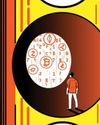
IN 2008, DURING THE GLOBAL financial crisis, the rupee depreciated by 25 percent in six weeks. Capital flows had been hit and exports were down. The US dollar reigned, and gold rallied as a safe asset. The net result was a depreciation from ₹40 to the dollar to ₹50 at the end of 2008.
The intervening years have seen the rupee lose its value against a host of currencies (it moved from ₹50 to ₹75 to the US dollar between 2010 and 2020). High oil prices in the early part of the decade were to blame for this, as was a tightening in US interest rates—the US Federal Reserve signalled intentions to hike rates too. But, at the same time, the rupee held its own against emerging market competitors—its Bric counterparts, Brazil, South Africa and Russia, whose economies are built on commodity exports.
But as India entered the Covid-19 crisis, the previous depreciation playbook did not kick in. A host of factors resulted in the rupee holding its own against the dollar. From January, it has seen a mere 2.8 percent depreciation to ₹73.5 to the dollar. While this is equally on account of the dollar’s weakness, it also points to an emerging strength in the rupee, which should stand India in good stead in the years to come. The flip side is that a strong currency is bad for exports—in particular, textiles, gems and jewellery, where countries typically lack pricing power. (Information technology exports are less price-sensitive.)
DOLLAR WEAKNESS
Esta historia es de la edición November 20, 2020 de Forbes India.
Comience su prueba gratuita de Magzter GOLD de 7 días para acceder a miles de historias premium seleccionadas y a más de 9,000 revistas y periódicos.
Ya eres suscriptor ? Conectar
Esta historia es de la edición November 20, 2020 de Forbes India.
Comience su prueba gratuita de Magzter GOLD de 7 días para acceder a miles de historias premium seleccionadas y a más de 9,000 revistas y periódicos.
Ya eres suscriptor? Conectar

Home-Cooked Meal Is Now Greatly Valued
The pandemic has also brought with it an improved focus on hygiene, use of technology in dining, rise of cloud kitchens and resurgence in popularity of Indian ingredients

Paytm 3.0 - Reaching Near Breakeven In Two Years
As of 2020, Vijay Shekhar Sharma’s super app for financial services had run up losses in thousands of crores. Now, as digital payments gets yet another boost courtesy Covid-19, he’s hopeful of reaching near breakeven in two years

THE PANDEMIC HAS CAUSED WOMEN GREATER LABOUR PAIN
Covid-19 has shown that women are more likely to face the brunt of job losses than men, and find fewer opportunities when they want to resume. That apart, several have to deal with increased hours of unpaid work at home and even domestic abuse

LEADERSHIP WILL BE ABOUT SEEING THE BIGGER PICTURE
Leaders must not only guard their teams first during a crisis, but also deal with stakeholders with respect and dignity. And apart from pursuing business goals, they should remain committed to our planet and the environment

PHILANTHROPY SHOULD BE HUMBLE, BUT NOT MODEST
Apart from building a flexible and resilient framework for the future, philanthropists, civil society and the government must work in tandem so that every rupee is absorbed on the ground

INTEGRATED HEALTH CARE, TECH WILL DISRUPT SECTOR
While clinical research will get a boost, having a skilled workforce and public spending on health care will be challenges in the near term

DIGITALISATION WILL HELP IN VALUE CREATION
As the pandemic brings technology and innovation to the core of business and daily life, the next decade will see about 150 million digital-first families in India

Industry 4.0: Climate Revolution?
Augmenting sustainability alongside digital capabilities is an economic, competitive and global opportunity for India’s businesses, but regulations need to reflect intent

EV Dream Still Miles Away
Electric vehicles have remained a buzzword in India for years. But not much has moved on ground due to high upfront costs, range anxiety and charging infrastructure

Living Waters
A virus has caused us to scramble for oxygen but our chokehold on the environment is slowly strangling the very waters that breathe life into us. The virus is a timely reminder: We are merely consumers, not producers of life’s breath on this planet